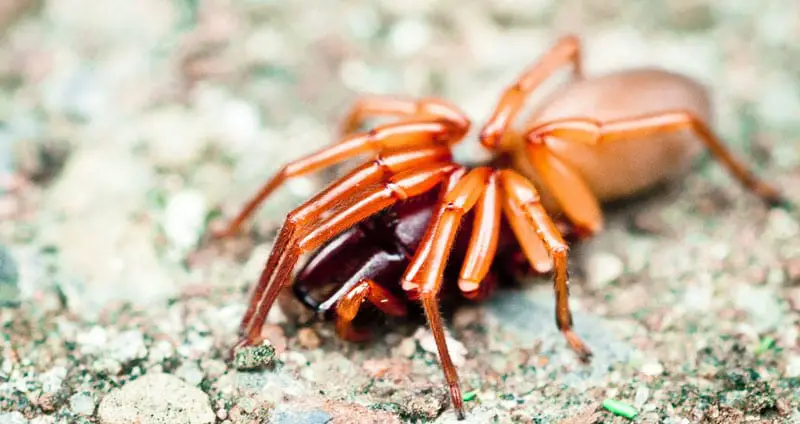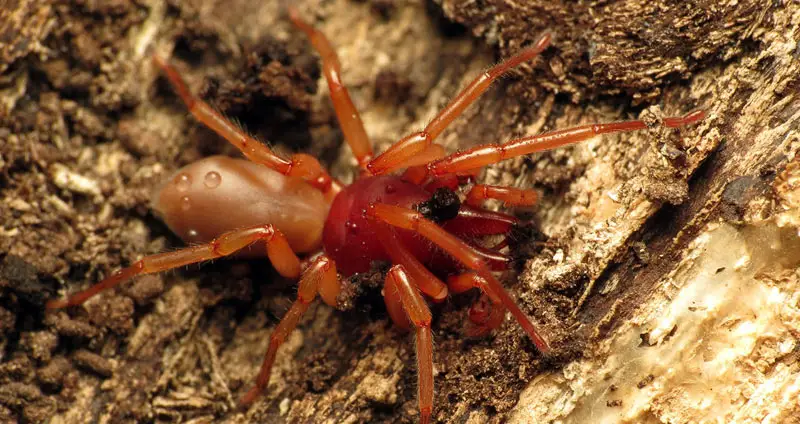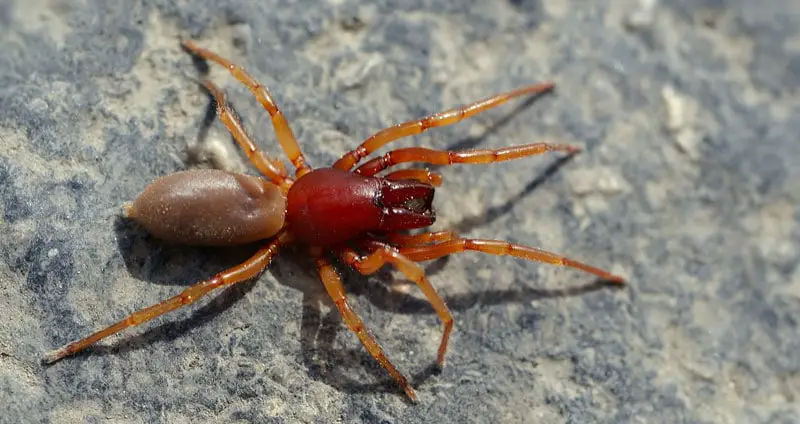The Woodlouse Spider, or Dysdera crocata, is a unique spider that gets its name from the staple food of its diet — woodlice.
It has other names, too, that all play off of the food that it eats. These names include woodlouse hunter, pillbug hunter, sowbug hunter, sowbug killer, and slater spider.
While this spider’s appearance may be unique and intimidating, it’s not considered threatening and is actually welcomed due to its beneficial behaviors.
Table of Contents
At A Glance
| Scientific Name | Dysdera crocata |
| Distribution | Eurasia, South Africa, Australia, New Zealand, and the Americas |
| Habitat | Near woodlice in logs, rocks, bricks, plant pots and under leaves |
| Size | 1/3″ to 3/5″ |
| Bite | Non-threatening |
| Lifespan | 2-3 years |
Woodlouse Spider Appearance
One thing to note about this spider is that it has a very unique appearance, making it easy to identify. It is hard to tell apart from its cousin Dysdera erythrina, but that species is much less common.
Female Woodlouse Spiders grow to a size of between 2/5″ and 3/5″ while males measure slightly smaller with an adult size of between 1/3″ and 2/5″.
The coloration of the Woodlouse Spider is broken into three main parts. Its cephalothorax is a deep red color, but its skinny abdomen is yellowish-brown with a distinct shine to it. From this body branches eight reddish-orange legs.
Due to the fact that this spider preys predominantly on woodlice, which are isopods, it’s developed a very effective way of killing them. These spiders have disproportionately large chelicerae, giving them a very threatening appearance.
Another interesting physical trait of this spider is that it only has six eyes that are arranged in an oval shape.
As stated, the Woodlouse Spider has a threatening appearance, but its habitat and general behavior doesn’t exacerbate that at all.

Woodlouse Spider Habitat
While this spider originated in the Mediterranean area, they’ve since spread to any other regions. This includes areas within North and South America, Eurasia, South Africa, Australia, and New Zealand.
In all of these regions, the general habitat of the Woodlouse Spider remains relatively consistent. These spiders can be found in a variety of of locations, but they’re almost always present in close proximity to a source of woodlice.
The most common places to see this spider include under rocks, bricks, logs, plant plots, and even within piles of dried leaves. Essentially any place that’s warm, sheltered, and is near their food.
During the day, these spiders create silken enclosures that add more structure and security to wherever they’re living. At night, though, is when they leave their enclosure and begin hunting.
As these are hunter spiders, they don’t create webs with the intention of catching food.
While they’re commonly found outside, they do sometimes make their way inside of homes if the climate outside becomes too extreme.

Woodlouse Spider Bite & Venom
For humans, the Woodlouse Spider poses virtually no threat. Despite its very large fangs, its venom is harmless to most, if not all people that are bitten.
Typically the most a bite will cause is a few hours of minor pain from the bite itself.
To other animals, though, the Woodlouse Spider poses more of a threat.
Its large chelicerae and wide gape allows it to easily subdue essentially any invertebrate that’s similar to a woodlouse. It’s even proven to be very dominant against other spiders and centipedes that may pose a threat.
Therefore, if you come across one of these spiders, don’t panic. Woodlouse Spiders are virtually harmless against humans.
However, they’re a very dominant and strong spider against their prey and any competition.

Woodlouse Spider Eggs & Spiderlings
The mating process of this spider is very aggressive. Both males and females run the risk of great harm due to their characteristically large chelicerae.
Like most spiders, after mating, the males leave the females in search of another mate while the female lays her egg sac.
Or, rather, the female lays more of an egg cocoon that contains about 70 eggs on average.
Once the spiderlings hatch, the mother cares for them for a brief period in the web before they go off on their own.
Random Woodlouse Spider Facts
- This spider is welcomed as a natural pesticide due to the fact that it eats harmful woodlice while leaving the foliage untouched.
- Females have been observed caring for their spiderlings after they hatch, which isn’t a common trait.
- Many males and females die during mating due to the injuries they sustain.
- While they most commonly eat woodlice, they also consume crickets, silverfish, millipedes, earwigs, and burying beetles.

